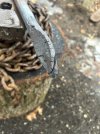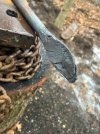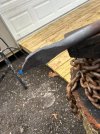tsavickas36
Gold Member
- Joined
- Jan 14, 2025
- Messages
- 43
A friend of mine handed me a threaded rod that he had cut out of a building they were demoing out. He said the original build was from the 1800s. He went through 6 sawzall blades to get through the piece so it was obviously hard.
When I put it into the forge and started hammering it out to see if he could use it to make some knives it started cracking all over the place.
I am very limited in my knowledge of why this would happen since it was definitely hardened steel before.
Any direction you can provide would be great. Thanks in advance.
When I put it into the forge and started hammering it out to see if he could use it to make some knives it started cracking all over the place.
I am very limited in my knowledge of why this would happen since it was definitely hardened steel before.
Any direction you can provide would be great. Thanks in advance.



